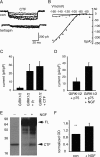p75 neurotrophin receptor mediates neuronal cell death by activating GIRK channels through phosphatidylinositol 4,5-bisphosphate
- PMID: 18171948
- PMCID: PMC6671158
- DOI: 10.1523/JNEUROSCI.2699-07.2008
p75 neurotrophin receptor mediates neuronal cell death by activating GIRK channels through phosphatidylinositol 4,5-bisphosphate
Abstract
The pan neurotrophin receptor p75(NTR) signals programmed cell death both during nervous system development and after neural trauma and disease in the adult. However, the molecular pathways by which death is mediated remain poorly understood. Here, we show that this cell death is initiated by activation of G-protein-coupled inwardly rectifying potassium (GIRK/Kir3) channels and a consequent potassium efflux. Death signals stimulated by neurotrophin-mediated cleavage of p75(NTR) activate GIRK channels through the generation and binding of phosphatidylinositol 4,5-bisphosphate [PtdIns(4,5)P2/PIP2] to GIRK channels. Both GIRK channel activity and p75(NTR)-mediated neuronal death are inhibited by sequestration of PtdIns(4,5)P2 and application of GIRK channel inhibitors, whereas pertussis toxin treatment has no effect. Thus, p75(NTR) activates GIRK channels without the need for G(i/o)-proteins. Our results demonstrate a novel mode of activation of GIRK channels, representing an early step in the p75(NTR)-mediated cell death pathway and suggesting a function for these channels during nervous system development.
Figures







References
-
- Barker PA, Barbee G, Misko TP, Shooter EM. The low affinity neurotrophin receptor, p75LNTR, is palmitoylated by thioester formation through cysteine 279. J Biol Chem. 1994;269:30645–30650. - PubMed
-
- Cain K, Langlais C, Sun XM, Brown DG, Cohen GM. Physiological concentrations of K+ inhibit cytochrome c-dependent formation of the apoptosome. J Biol Chem. 2001;276:41985–41990. - PubMed
-
- Carpenter CL, Tolias KF, Van Vugt A, Hartwig J. Lipid kinases are novel effectors of the GTPase Rac1. Adv Enzyme Regul. 1999;39:299–312. - PubMed
-
- Chen SC, Ehrhard P, Goldowitz D, Smeyne RJ. Developmental expression of the GIRK family of inward rectifying potassium channels: implications for abnormalities in the weaver mutant mouse. Brain Res. 1997;778:251–264. - PubMed
Publication types
MeSH terms
Substances
LinkOut - more resources
Full Text Sources
Research Materials
